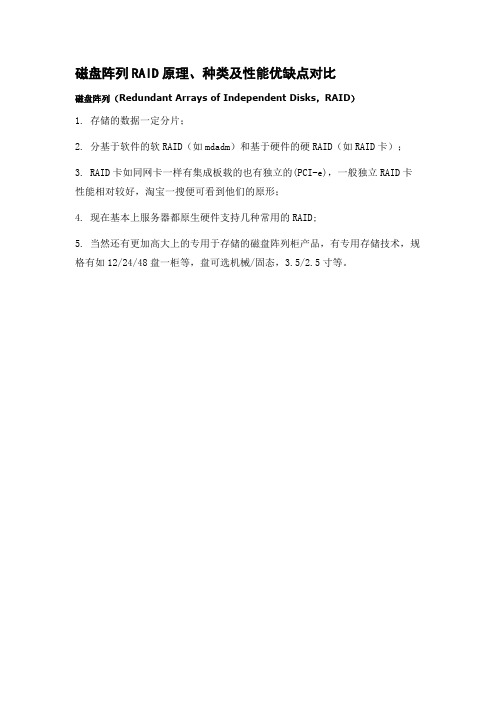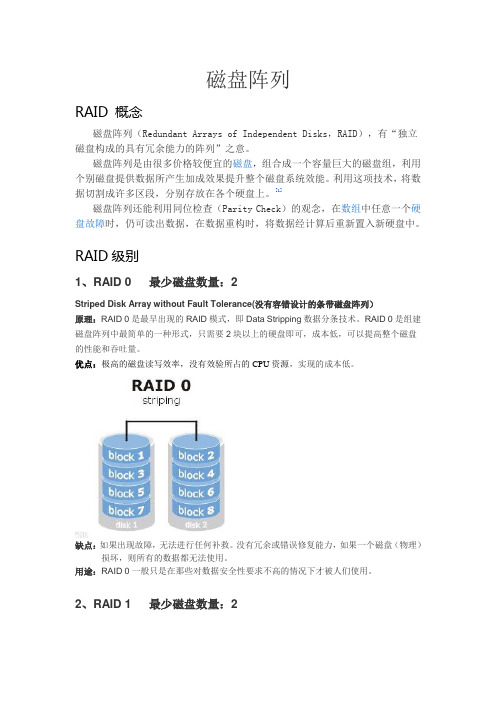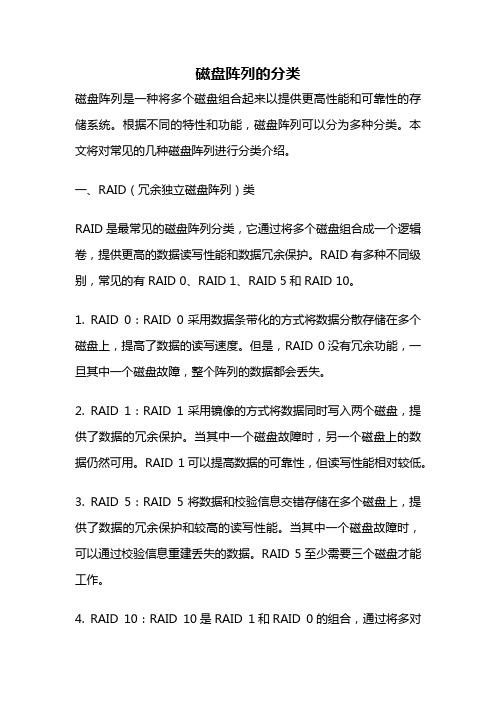raid原理和分类
磁盘阵列各种RAID原理、磁盘使用率

磁盘阵列RAID原理、种类及性能优缺点对比磁盘阵列(Redundant Arrays of Independent Disks,RAID)1. 存储的数据一定分片;2. 分基于软件的软RAID(如mdadm)和基于硬件的硬RAID(如RAID卡);3. RAID卡如同网卡一样有集成板载的也有独立的(PCI-e),一般独立RAID卡性能相对较好,淘宝一搜便可看到他们的原形;4. 现在基本上服务器都原生硬件支持几种常用的RAID;5. 当然还有更加高大上的专用于存储的磁盘阵列柜产品,有专用存储技术,规格有如12/24/48盘一柜等,盘可选机械/固态,3.5/2.5寸等。
近来想建立一个私有云系统,涉及到安装使用一台网络存储服务器。
对于服务器中硬盘的连接,选用哪种RAID模式能准确满足需求收集了资料,简单整理后记录如下:一、RAID模式优缺点的简要介绍目前被运用较多的RAID模式其优缺点大致是这样的:1、RAID0模式优点:在RAID 0状态下,存储数据被分割成两部分,分别存储在两块硬盘上,此时移动硬盘的理论存储速度是单块硬盘的2倍,实际容量等于两块硬盘中较小一块硬盘的容量的2倍。
缺点:任何一块硬盘发生故障,整个RAID上的数据将不可恢复。
备注:存储高清电影比较适合。
2、RAID1模式优点:此模式下,两块硬盘互为镜像。
当一个硬盘受损时,换上一块全新硬盘(大于或等于原硬盘容量)替代原硬盘即可自动恢复资料和继续使用,移动硬盘的实际容量等于较小一块硬盘的容量,存储速度与单块硬盘相同。
RAID 1的优势在于任何一块硬盘出现故障是,所存储的数据都不会丢失。
缺点:该模式可使用的硬盘实际容量比较小,仅仅为两颗硬盘中最小硬盘的容量。
备注:非常重要的资料,如数据库,个人资料,是万无一失的存储方案。
3、RAID 0+1模式RAID 0+1是磁盘分段及镜像的结合,采用2组RAID0的磁盘阵列互为镜像,它们之间又成为一个RAID1的阵列。
raid级别分类及功能

raid级别分类及功能Raid级别分类及功能一、RAID 0:提升读写速度,无容错能力RAID 0是最简单的RAID级别,它通过将数据分散地存储在多个磁盘上,从而提升了读写速度。
在RAID 0中,数据被分割成多个块,并且每个块都被写入到不同的磁盘上。
因此,当进行读取操作时,可以同时从多个磁盘上读取数据,从而显著提高了读取速度。
同样地,当进行写入操作时,数据也会被分散地写入到多个磁盘上,从而提高了写入速度。
然而,RAID 0没有容错能力,如果其中一个磁盘出现故障,所有数据都将丢失。
二、RAID 1:提供完全冗余,读取速度较快RAID 1是一种提供完全冗余的RAID级别。
在RAID 1中,数据被同时写入到多个磁盘上,这样即使其中一个磁盘出现故障,其他磁盘上的数据仍然完好无损。
因此,RAID 1具有很高的可靠性,可以保护数据免受硬件故障的影响。
此外,由于数据可以从多个磁盘上同时读取,RAID 1还具有较快的读取速度。
然而,RAID 1的写入速度较慢,因为数据需要同时写入多个磁盘。
三、RAID 5:提供容错能力和较快的读写速度RAID 5是一种常用的RAID级别,它提供了容错能力和较快的读写速度。
在RAID 5中,数据和校验信息被分散地存储在多个磁盘上。
校验信息用于恢复数据,以防某个磁盘发生故障。
当进行读取操作时,RAID 5可以同时从多个磁盘上读取数据,从而提高了读取速度。
在写入操作时,RAID 5需要计算校验信息,并将其写入到对应的磁盘上,因此写入速度较慢。
然而,RAID 5的容错能力使得即使其中一个磁盘发生故障,数据仍然可以被恢复。
四、RAID 6:提供更高的容错能力和较快的读写速度RAID 6是在RAID 5的基础上进一步提高容错能力的RAID级别。
在RAID 6中,数据和两个独立的校验信息被分散地存储在多个磁盘上。
这意味着即使同时发生两个磁盘故障,数据仍然可以被恢复。
RAID 6不仅提供了更高的容错能力,还保持了较快的读写速度。
什么是RAIDRAID0,RAID1,RAID2,RAID3,RAID4,RAID5,RAID6,RAID10

一.什么是RAID:RAID是“Redundant Array of Independent Disk”的缩写,中文意思是独立冗余磁盘阵列。
冗余磁盘阵列技术诞生于1987年,由美国加州大学伯克利分校提出。
RAID磁盘阵列(Redundant Array of Independent Disks)简单地解释,就是将N台硬盘通过RAID Controller(分Hardware,Software)结合成虚拟单台大容量的硬盘使用,其特色是N台硬盘同时读取速度加快及提供容错性Fault Tolerant,所以RAID是当成平时主要访问Data的Storage不是Backup Solution。
在RAID有一基本概念称为EDAP(Extended Data Availability and Protection),其强调扩充性及容错机制,也是各家厂商如:Mylex,IBM,HP,Compaq,Adaptec,Infortrend等诉求的重点,包括在不须停机情况下可处理以下动作:RAID 磁盘阵列支援自动检测故障硬盘;RAID 磁盘阵列支援重建硬盘坏轨的资料;RAID 磁盘阵列支援支持不须停机的硬盘备援 Hot Spare;RAID 磁盘阵列支援支持不须停机的硬盘替换 Hot Swap;RAID 磁盘阵列支援扩充硬盘容量等。
一旦RAID阵列出现故障,硬件服务商只能给客户重新初始化或者REBUILD,这样客户数据就会无法挽回。
因此对RAID0、RAID1、RAID5以及组合型的RAID系列磁盘阵列数据恢复,出现故障以后只要不对阵列作初始化操作,就有机会恢复出故障RAID磁盘阵列的数据。
二.关于RAID的技术规范介绍(1)RAID技术规范简介冗余磁盘阵列技术最初的研制目的是为了组合小的廉价磁盘来代替大的昂贵磁盘,以降低大批量数据存储的费用,同时也希望采用冗余信息的方式,使得磁盘失效时不会使对数据的访问受损失,从而开发出一定水平的数据保护技术,并且能适当的提升数据传输速度。
RAID分类及特点

在通常情况下,RAID有如下几种分类:RAID0:由多个硬盘并发协同工作完成数据的读写,数据被均匀分布在各个硬盘上,一般情况下,使用的硬盘越多,读写的速度越快。
RAID0的特点是读写速度快,并且价格便宜;缺点是安全性相对较差,因为在RAID0中的一个硬盘出现故障时,整个阵列的数据将会丢失。
RAID0是最快和最有效的磁盘阵列类型,但没有容错功能。
RAID1:称为磁盘镜像。
原理是在两个硬盘之间建立完全的镜像,即所有数据会被同时存放到两个物理硬盘上,当一个磁盘出故障时,仍可从另一个硬盘中读取数据,因此安全性得到保障。
但系统的成本大大提高,因为系统的实际有效硬盘空间仅为所有硬盘空间的一半。
RAID 0+1:为RAID0和RAID1的组合,即由两个完全相同配置的RAID0形成镜像关系,既提高了阵列的读取速度,又保障了阵列数据的安全性,当然,为此付出的代价同样是价格昂贵。
RAID3:是把数据分成多个“块”,按照一定的容错算法,存放在N+1个硬盘上,实际数据占用的有效空间为N个硬盘的空间总和,而第N+1个硬盘上存储的数据是校验容错信息,当这N+1个硬盘中的其中一个硬盘出现故障时,从其它N个硬盘中的数据也可以恢复原始数据,这样,仅使用这N个硬盘也可以带伤继续工作(如采集和回放素材),当更换一个新硬盘后,系统可以重新恢复完整的校验容错信息。
由于在一个硬盘阵列中,多于一个硬盘同时出现故障率的几率很小,所以一般情况下,使用RAID3,安全性是可以得到保障的。
与RAID0相比,RAID3在读写速度方面相对较慢。
RAID5:RAID5 和RAID3的原理非常类似,硬盘的有效使用空间也是一样的,只是其算法以及数据分块方式有所不同。
使用的容错算法和分块大小决定RAID使用的应用场合,在通常情况下,RAID3比较适合大文件类型且安全性要求较高的应用,如视频编辑、硬盘播出机、大型数据库等;而RAID5适合较小文件的应用,如文字、图片、小型数据库等。
磁盘阵列各种RAID原理磁盘使用率

磁盘阵列各种RAID原理磁盘使用率RAID(Redundant Array of Inexpensive Disks)是一种磁盘阵列,可以将多块普通的磁盘拼接在一起形成更高效、可靠的数据存储系统。
它可以通过将存储空间划分成若干块虚拟磁盘来提高磁盘访问性能。
存储空间划分的方式共分为9种,分别是RAID0,RAID1,RAID2,RAID3,RAID4,RAID5,RAID6,RAID7和RAID10,其中RAID 0、RAID 1、RAID 5和RAID 10是最常用的四种RAID级别。
RAID0是把多块磁盘组合成一个虚拟磁盘,通过分割、重组来提升数据的存取速度,这种RAID把多块磁盘拼接在一起形成一个虚拟磁盘,不提供数据冗余,磁盘使用率比较高,但是其可靠性较低。
RAID1是把多块相同容量的磁盘拼接在一起形成一个虚拟磁盘,不同的是,这种RAID方式采用镜像技术,每个磁盘上的数据都会与另一块磁盘上的数据完全相同,提供了更好的可靠性,磁盘使用率较低,只有一半的磁盘空间可以使用。
RAID5是一种磁盘阵列中比较常用的RAID级别,它将磁盘阵列中的磁盘分成两种,一般磁盘和校验磁盘,这样就可以在一个虚拟磁盘上存储大量数据,任一块磁盘出现问题时,系统可以通过校验磁盘上的冗余数据来恢复受损的数据,并且RAID5提供了比RAID1更高的数据存储空间,磁盘使用率也比RAID1更高。
磁盘阵列原理

磁盘阵列原理磁盘阵列(RAID)是一种通过将多个磁盘驱动器合并成一个逻辑单元来提供数据冗余和性能提升的技术。
磁盘阵列利用磁盘级别的冗余来提供数据的备份和恢复能力,并通过将数据分布在多个磁盘上来提高数据访问速度。
在本文中,我们将探讨磁盘阵列的原理以及它是如何工作的。
1. 磁盘阵列的概念和分类磁盘阵列是一种将多个独立的磁盘驱动器组合在一起,形成一个逻辑单元的技术。
根据不同的需求,磁盘阵列可以被划分为多个级别,常见的包括RAID 0、RAID 1、RAID 5、RAID 6等级别。
每个级别都有其特定的数据保护和性能特性。
2. RAID 0RAID 0将数据分块并分布到多个磁盘上,以提高数据的读写性能。
它通过在多个磁盘上同时读取和写入数据来实现并行访问。
然而,RAID 0没有冗余机制,一旦其中一个磁盘损坏,所有数据将会丢失。
3. RAID 1RAID 1通过将数据复制到多个磁盘上来提供冗余能力。
每个数据块都会被复制到两个或更多的磁盘上,以确保数据的完整性。
当其中一个磁盘发生故障时,系统可以从其他磁盘中恢复数据。
4. RAID 5RAID 5采用分布式奇偶校验的方式来提供冗余能力。
它将数据分块并分布到多个磁盘上,同时计算奇偶校验信息并存储在不同的磁盘上。
当其中一个磁盘损坏时,系统可以通过计算奇偶校验信息来恢复数据。
5. RAID 6RAID 6在RAID 5的基础上增加了第二个奇偶校验信息。
这意味着RAID 6可以容忍两个磁盘的故障,提供更高的数据可靠性。
6. 磁盘阵列的工作原理磁盘阵列通过控制器来管理和操作多个磁盘驱动器。
控制器负责将数据分块并分布到多个磁盘上,同时监测磁盘的状态。
当磁盘发生故障时,控制器可以根据不同的级别(如RAID 1、RAID 5等)来执行数据的恢复操作。
7. 磁盘阵列的优势和应用磁盘阵列提供了数据的冗余和性能提升能力,可以提高数据的可靠性和访问速度。
它广泛应用于服务器、存储系统、数据库等需要高可靠性和高性能的场景。
raid分类及特点

raid分类及特点:
RAID分类主要有以下几种:
1.RAID 0:又称为快速模式或数据分块。
它把数据分布在多个盘上,实际上是非冗余
阵列,无冗余信息。
读写传输数据的速度最快,但任何一块硬盘发生故障,整个RAID 上的数据将不可恢复。
2.RAID 1:又称为镜像模式或安全模式。
两块硬盘互为镜像、互为备份。
任何一块硬
盘出现故障时,只需要取下故障硬盘、换上一块容量大于或等于故障硬盘容量的硬盘即可自动恢复数据和重组RAID模式,所存储的数据安全性高。
3.RAID 3:至少需要3块硬盘,其中一颗用来储存纠错数据。
当有一块硬盘故障时,
只需要取下故障硬盘、换上一块容量大于或等于故障硬盘容量的硬盘即可自动恢复数据和重组RAID,数据可以从其余硬盘上的数据和纠错数据中恢复出来,安全性好。
4.RAID 5:块交叉分布式奇偶校验盘阵列,是旋转奇偶校验独立存取的阵列。
即数据
以块(块大小可变)交叉的方式存于各盘,但无专用的校验盘,而是把冗余的奇偶校验信息均匀地分布在所有磁盘上。
Raid0,Raid1,Raid5,Raid10的异同

Raid0,Raid1,Raid5,Raid10的异同1.RAID0#定义:RAID 0⼜称为Stripe或Striping,它代表了所有RAID级别中最⾼的存储性能。
RAID 0提⾼存储性能的原理是把连续的数据分散到多个磁盘上存取,这样,系统有数据请求就可以被多个磁盘并⾏的执⾏,每个磁盘执⾏属于它⾃⼰的那部分数据请求。
这种数据上的并⾏操作可以充分利⽤总线的带宽,显著提⾼磁盘整体存取性能。
#⼯作原理:系统向三个磁盘组成的逻辑硬盘(RAID0 磁盘组)发出的I/O数据请求被转化为3项操作,其中的每⼀项操作都对应于⼀块物理硬盘。
通过建⽴RAID 0,原先顺序的数据请求被分散到所有的三块硬盘中同时执⾏。
从理论上讲,三块硬盘的并⾏操作使同⼀时间内磁盘读写速度提升了3倍。
但由于总线带宽等多种因素的影响,实际的提升速率肯定会低于理论值,但是,⼤量数据并⾏传输与串⾏传输⽐较,提速效果显著显然⽏庸置疑。
#优缺点:读写性能是所有RAID级别中最⾼的。
RAID 0的缺点是不提供数据冗余,因此⼀旦⽤户数据损坏,损坏的数据将⽆法得到恢复。
RAID0运⾏时只要其中任⼀块硬盘出现问题就会导致整个数据的故障。
⼀般不建议企业⽤户单独使⽤。
#总结:磁盘空间使⽤率:100%,故成本最低。
读性能:N*单块磁盘的读性能写性能:N*单块磁盘的写性能冗余:⽆,任何⼀块磁盘损坏都将导致数据不可⽤。
2.RAID1#定义:RAID 1通过磁盘数据镜像实现数据冗余,在成对的独⽴磁盘上产⽣互为备份的数据。
当原始数据繁忙时,可直接从镜像拷贝中读取数据,因此RAID 1可以提⾼读取性能。
RAID 1是磁盘阵列中单位成本最⾼的,但提供了很⾼的数据安全性和可⽤性。
当⼀个磁盘失效时,系统可以⾃动切换到镜像磁盘上读写,⽽不需要重组失效的数据。
#⼯作原理:RAID1是将⼀个两块硬盘所构成RAID磁盘阵列,其容量仅等于⼀块硬盘的容量,因为另⼀块只是当作数据“镜像”。
了解电脑硬盘阵列(RAID)如何提升数据存储性能与冗余性

了解电脑硬盘阵列(RAID)如何提升数据存储性能与冗余性电脑硬盘阵列(RAID)是一种通过将多个硬盘组合起来工作来提升数据存储性能和提供数据冗余性的技术。
本文将详细介绍RAID的各种级别和其工作原理,以及它如何在数据存储方面发挥作用。
一、RAID的概述RAID,全称为“Redundant Array of Independent Disks”,即独立磁盘冗余阵列。
它旨在通过同时使用多个硬盘来提升数据存储性能和增强数据的容错能力。
RAID可以通过数据分布和冗余化来提高系统性能和可靠性。
二、RAID的级别RAID有多种级别,每个级别都有其独特的特点和适用场景。
下面将介绍几个常见的RAID级别:1. RAID 0RAID 0是最简单的RAID级别,它通过将数据分块地存储到多个硬盘上来提升读写速度。
RAID 0具有良好的性能,但没有冗余功能,一旦某个硬盘出现故障,所有数据将会丢失。
2. RAID 1RAID 1是一种镜像级别的RAID,它要求至少使用两个硬盘。
RAID 1通过将数据同时写入两个硬盘来实现数据冗余,从而提供更高的可靠性。
当其中一个硬盘出现故障时,系统可以自动切换到另一个硬盘继续工作。
3. RAID 5RAID 5通过将数据和校验信息分布存储在多个硬盘上来实现数据冗余和性能提升。
RAID 5至少需要三个硬盘。
当其中一个硬盘出现故障时,RAID 5可以根据校验信息恢复数据。
RAID 5是一种性能和冗余兼顾的RAID级别。
4. RAID 10RAID 10是RAID 1和RAID 0的结合,需要至少四个硬盘。
RAID 10将数据同时写入多对镜像硬盘,然后再将镜像硬盘组合成一个RAID 0阵列。
RAID 10提供了优秀的性能和较高的冗余性。
三、RAID的工作原理RAID使用不同的技术和算法来实现数据的分布和冗余。
下面将介绍几种常见的RAID技术:1. 块级分布在RAID中,数据被分成固定大小的块,然后分布存储在不同的硬盘上。
磁盘阵列(raid分类介绍)

磁盘阵列RAID 概念磁盘阵列(Redundant Arrays of Independent Disks,RAID),有“独立磁盘构成的具有冗余能力的阵列”之意。
磁盘阵列是由很多价格较便宜的磁盘,组合成一个容量巨大的磁盘组,利用个别磁盘提供数据所产生加成效果提升整个磁盘系统效能。
利用这项技术,将数据切割成许多区段,分别存放在各个硬盘上。
[1]磁盘阵列还能利用同位检查(Parity Check)的观念,在数组中任意一个硬盘故障时,仍可读出数据,在数据重构时,将数据经计算后重新置入新硬盘中。
RAID级别1、RAID 0 最少磁盘数量:2Striped Disk Array without Fault Tolerance(没有容错设计的条带磁盘阵列)原理:RAID 0是最早出现的RAID模式,即Data Stripping数据分条技术。
RAID 0是组建磁盘阵列中最简单的一种形式,只需要2块以上的硬盘即可,成本低,可以提高整个磁盘的性能和吞吐量。
优点:极高的磁盘读写效率,没有效验所占的CPU资源,实现的成本低。
缺点:如果出现故障,无法进行任何补救。
没有冗余或错误修复能力,如果一个磁盘(物理)损坏,则所有的数据都无法使用。
用途:RAID 0一般只是在那些对数据安全性要求不高的情况下才被人们使用。
2、RAID 1 最少磁盘数量:2Mirroring and Duplexing (相互镜像)原理:RAID 1称为磁盘镜像,原理是把一个磁盘的数据镜像到另一个磁盘上,也就是说数据在写入一块磁盘的同时,会在另一块闲置的磁盘上生成镜像文件,在不影响性能情况下最大限度的保证系统的可靠性和可修复性上。
优点:理论上两倍的读取效率,系统中任何一对镜像盘中至少有一块磁盘可以使用,甚至可以在一半数量的硬盘出现问题时系统都可以正常运行,当一块硬盘失效时,系统会忽略该硬盘,转而使用剩余的镜像盘读写数据,具备很好的磁盘冗余能力。
缺点:对数据的写入性能下降,磁盘的利用率最高只能达到50%(使用两块盘的情况下),是所有RAID级别中最低的。
图文并茂RAID技术全解–RAID0、RAID1、RAID5、RAID10

图⽂并茂RAID技术全解–RAID0、RAID1、RAID5、RAID10图⽂并茂 RAID 技术全解 – RAID0、RAID1、RAID5、RAID100…… RAID 技术相信⼤家都有接触过,尤其是服务器运维⼈员,RAID 概念很多,有时候会概念混淆。
这篇⽂章为⽹络转载,写得相当不错,它对 RAID 技术的概念特征、基本原理、关键技术、各种等级和发展现状进⾏了全⾯的阐述,并为⽤户如何进⾏应⽤选择提供了基本原则,对于初学者应该有很⼤的帮助。
⼀、RAID 概述 1988 年美国加州⼤学伯克利分校的 D. A. Patterson 教授等⾸次在论⽂ “A Case of Redundant Array of Inexpensive Disks” 中提出了RAID 概念 [1] ,即廉价冗余磁盘阵列( Redundant Array of Inexpensive Disks )。
由于当时⼤容量磁盘⽐较昂贵, RAID 的基本思想是将多个容量较⼩、相对廉价的磁盘进⾏有机组合,从⽽以较低的成本获得与昂贵⼤容量磁盘相当的容量、性能、可靠性。
随着磁盘成本和价格的不断降低, RAID 可以使⽤⼤部分的磁盘, “廉价” 已经毫⽆意义。
因此, RAID 咨询委员会( RAID Advisory Board, RAB )决定⽤ “ 独⽴ ” 替代 “ 廉价 ” ,于时 RAID 变成了独⽴磁盘冗余阵列( Redundant Array of Independent Disks )。
但这仅仅是名称的变化,实质内容没有改变。
RAID 这种设计思想很快被业界接纳, RAID 技术作为⾼性能、⾼可靠的存储技术,已经得到了⾮常⼴泛的应⽤。
RAID 主要利⽤数据条带、镜像和数据校验技术来获取⾼性能、可靠性、容错能⼒和扩展性,根据运⽤或组合运⽤这三种技术的策略和架构,可以把 RAID 分为不同的等级,以满⾜不同数据应⽤的需求。
raid技术原理

raid技术原理RAID(Redundant Array of Independent Disks)是一种存储技术,它将多个独立的硬盘驱动器组合在一起,形成一个逻辑上的单个存储单元。
RAID技术有不同的级别(RAID 0、RAID 1、RAID 5 等),每种级别都有其独特的特性和原理。
以下是一些常见的RAID 级别及其原理:1. RAID 0(条带化):-原理:将数据分成多个块,依次写入不同的硬盘上。
这样,读写操作可以并行进行,提高性能。
-特点:提高性能,但没有冗余,一个硬盘故障会导致数据不可用。
2. RAID 1(镜像):-原理:将相同的数据同时写入两个硬盘,形成镜像。
数据冗余,读操作可以并行进行,写操作会稍慢。
-特点:提供冗余,任何一个硬盘故障都不会导致数据丢失。
3. RAID 5:-原理:将数据和校验信息交错存储在不同硬盘上,通过对数据进行异或运算生成校验信息。
提供读取和写入性能,并提供一定程度的冗余。
-特点:提高性能,允许一个硬盘故障,通过校验信息进行数据恢复。
4. RAID 6:-原理:类似RAID 5,但使用两个校验信息块,通常是对数据块的两次异或运算,提供更高级别的冗余,可以容忍两个硬盘故障。
-特点:冗余性更高,但写入性能相对较低。
5. RAID 10:-原理:将多个硬盘分为两组,每组内采用RAID 1 的镜像方式,然后采用RAID 0 的条带化方式跨组。
-特点:提供了高性能和冗余,但需要更多的硬盘。
RAID 技术的目标通常是提高存储系统的性能、可用性和容错性。
选择哪种RAID 级别取决于应用的要求和对性能与冗余的权衡。
raid原理

raid原理
RAID(冗余磁盘阵列)是一种使用多个磁盘驱动器组合成一个逻辑单元的技术,旨在提高数据存储的性能和可靠性。
RAID采用不同的技术级别,每个级别有其独特的原理。
下面将简要介绍几种常见的RAID级别的原理:
1. RAID 0:RAID 0采用数据条带化的方式将数据均匀地分布在多个磁盘驱动器上。
数据被分为多个块,并在驱动器之间交替写入。
这种条带化方式提高了数据的读写速度,但没有容错能力,因为当一个驱动器出现问题时,整个数组的数据都会受到影响。
2. RAID 1:RAID 1采用镜像方式存储数据,将相同的数据同时写入到至少两个磁盘驱动器中。
这种方式提供了数据的冗余备份,当一个驱动器发生故障时,系统可以从另一个驱动器中读取数据。
RAID 1的优点是容错能力强,但写入速度相对较慢。
3. RAID 5:RAID 5通过将数据和奇偶校验信息交错地分布在多个磁盘驱动器上,实现数据的冗余和读写性能的提升。
奇偶校验信息用于恢复数据,在某个驱动器发生故障时,系统可以通过奇偶校验信息计算出丢失的数据。
RAID 5至少需要三个驱动器,写入速度相对较慢,但具有较好的性能和容错能力。
4. RAID 10:RAID 10是RAID 0和RAID 1的结合,采用条带化和镜像的方式存储数据。
RAID 10至少需要四个驱动器,通过将数据分为多个块并同时在镜像组中存储,提供了较高的读
写性能和容错能力。
这些是常见的RAID级别,每个级别都具有不同的原理和应用场景。
通过选择适当的RAID级别,可以根据实际需求提高数据存储的性能和可靠性。
RAID的级别和原理

RAID的级别和原理
RAID(Redundant Array of Independent Disks,独立磁盘阵列)是
一种在两台甚至更多的服务器上组合逻辑磁盘的一种存储技术,它可以给
存储系统带来高可靠性和高性能。
它也是一种可以实现各种磁盘阵列虚拟化,有效提高存储性能和可靠性的技术。
RAID级别有许多,它们的组织方式和功能也不同。
具体来说,RAID0,RAID1,RAID5,RAID6,RAID10,RAID50和RAID60均为非常常见的RAID
级别。
RAID0,也称为快速存储池或者磁盘阵列,是RAID特有的级别,其基
本原理是将多块磁盘分割成几块虚拟磁盘,使得多个物理磁盘的性能可以
叠加达到更高的系统性能,并且不需要添加额外的比较开销。
RAID0不支
持纠错,任何一块物理磁盘损坏则导致所有的数据全部丢失。
RAID1由两块或多块磁盘组成,使用两个磁盘镜像来实现高可用性,
可以防止任何单块磁盘故障而造成的数据丢失。
然而,RAID1的缺点在于,它没有第三块磁盘防止数据丢失,当两块磁盘都出现故障的时候,会导致
数据的全部丢失。
RAID5是以软件RAID磁盘阵列的方式提高容量和性能的磁盘阵列技术,其原理是使用特殊的方式将多块物理磁盘逻辑联结为一个虚拟磁盘,
并在这些物理磁盘上创建一个复制的冗余数据块用于错误校正。
RAID0、RAID1详解

RAID0工作原理
01
数据被分割成大小相等的块,并按照一定的顺序分配给各个磁 盘。
02
每个磁盘都独立地执行读写操作,不受其他磁盘的影响。
当数据被读取时,系统可以同时从多个磁盘中获取数据块,显
03
著提高了数据传输速度。
2
通过将多个RAID0和RAID1阵列组合在一起,可 以获得更高的I/O性能和数据冗余性,以满足不 同应用的需求。
3
混合RAID技术还可以实现自动数据迁移和分层存 储,以提高存储效率和降低成本。
自动配置与优化
自动配置与优化技术可以自动调整 RAID配置和参数,以实现最佳性能和 可靠性。
通过实时监控存储系统的性能和健康状况, 自动配置与优化技术可以自动调整RAID级 别、条带大小、数据冗余等参数,以实现最 佳的系统性能和可靠性。
适用场景比较
RAID0适用于对性能要求较高,但对 数据安全性要求不高的场景,如Web 服务器、邮件服务器等。
VS
RAID1适用于对数据安全性要求较高, 但对性能要求不高的场景,如数据库 服务器、文件服务器等。
优缺点比较
优点
RAID0提高了读写性能,RAID1保证了数据 的安全性。
缺点
RAID0的数据安全性较低,一旦一个磁盘出 现故障,所有数据都可能丢失。而RAID1的 性能相对较低,因为数据需要同时写入两个 或更多的磁盘。
在云存储环境中,RAID0可以为云 服务提供商提供高带宽和IOPS, 满足大量用户同时访问的需求。
RAID1
对于需要保证数据可靠性的云服 务,如企业级备份、关键任务应 用程序等,RAID1可以提供数据 冗余和错误恢复功能。
什么是RAID如何使用RAID提升数据安全性和读写速度

什么是RAID如何使用RAID提升数据安全性和读写速度RAID (Redundant Array of Independent Disks) 是一种通过将多个硬盘驱动器组合在一起来提升数据存储性能和可靠性的技术。
通过将数据分布在多个硬盘上,RAID可以实现数据的冗余备份和并行读写,从而提高数据安全性和读写速度。
RAID技术的原理是将多个硬盘组织成一个逻辑上的存储单元,通过不同的RAID级别或配置方式来实现对数据的备份、分布和读写操作。
下面将介绍几种常见的RAID级别和它们的工作原理。
1. RAID 0:RAID 0通过将数据分散在多个硬盘上来提高读写速度。
它将数据划分成块,并将每个块分配到不同的硬盘上,实现并行读写操作。
由于数据被分散存储,当其中一个硬盘故障时,整个数据也会丢失,因此RAID 0并不提供冗余备份功能。
2. RAID 1:RAID 1通过将数据完全复制到多个硬盘上来提供数据冗余备份。
每个硬盘上存储的数据完全相同,当其中一个硬盘故障时,其他硬盘上的数据可以继续访问。
RAID 1具有很高的可靠性,但相对于RAID 0来说读写速度较慢。
3. RAID 5:RAID 5通过将数据和奇偶校验信息分散存储在多个硬盘上来提供数据冗余备份和读取速度的平衡。
当其中一个硬盘故障时,根据奇偶校验信息可以恢复数据。
RAID 5至少需要三个硬盘来实现,其中一个用于存储奇偶校验信息。
它既提供了高读取性能,又具备数据冗余备份的功能。
4. RAID 10:RAID 10是RAID 1和RAID 0的组合,它将多个硬盘分为两组,每组内部使用RAID 1的镜像备份方式,然后通过RAID 0的方式将两组硬盘进行条带化存储。
RAID 10既有较高的读写速度,又具备了数据的冗余备份。
使用RAID技术可以提升数据的安全性和读写速度。
首先,通过数据的冗余备份,即使其中一个硬盘发生故障,也能确保数据的完整性。
其次,通过并行读写操作,RAID可以提高读写速度,从而加快数据的传输速度和访问响应时间。
磁盘阵列基本原理

磁盘阵列基本原理磁盘阵列(RAID)是一种通过将多个磁盘驱动器组合在一起来提供更高性能、更大存储容量和更高容错能力的技术。
它通过将数据分散存储在多个磁盘上,以实现更快的数据读写速度和更好的数据冗余保护。
RAID技术有多种级别,每种级别都有其独特的数据分布和冗余机制。
下面将介绍几种常见的RAID级别及其基本原理。
1. RAID 0:RAID 0是一种条带化(striping)技术,它将数据分散存储在多个磁盘上,从而提高数据读写速度。
数据被分成块,并按顺序写入不同的磁盘。
当读取数据时,多个磁盘可以同时工作,从而提供更高的吞吐量。
然而,RAID 0没有冗余机制,如果其中一个磁盘故障,所有数据都将丢失。
2. RAID 1:RAID 1是一种镜像(mirroring)技术,它将数据同时写入两个磁盘,从而实现数据的冗余备份。
当其中一个磁盘故障时,另一个磁盘仍然可以提供数据访问。
RAID 1提供了很高的数据可靠性,但存储容量利用率较低,因为每一个数据都需要在两个磁盘上存储一份。
3. RAID 5:RAID 5是一种条带化和分布式奇偶校验(distributed parity)技术的组合。
它将数据和奇偶校验信息分别存储在多个磁盘上,以提供更高的数据读写速度和冗余保护。
奇偶校验信息用于恢复故障磁盘上的数据。
RAID 5至少需要三个磁盘,其中一个磁盘用于存储奇偶校验信息。
当其中一个磁盘故障时,系统可以通过奇偶校验信息计算出丢失的数据。
4. RAID 6:RAID 6是在RAID 5的基础上增加了第二个奇偶校验信息。
它需要至少四个磁盘,并可以容忍两个磁盘的故障。
RAID 6提供了更高的容错能力,但相应地增加了存储开消。
5. RAID 10:RAID 10是RAID 1和RAID 0的组合。
它将数据分散存储在多个磁盘上,并通过镜像技术实现数据的冗余备份。
RAID 10提供了更高的数据读写速度和数据可靠性,但需要至少四个磁盘,且存储容量利用率较低。
raid介绍简单易懂

raid介绍简单易懂RAID(冗余阵列独立磁盘,Redundant Array of Independent Disks)是一种通过将多个硬盘组合在一起的技术,以提高数据存储性能、可靠性和/或容量。
RAID 技术通过在多个硬盘之间分配数据和/或进行冗余备份来实现这些目标。
以下是几种常见的 RAID 级别,每个级别都有不同的工作原理和适用场景:1. RAID 0 - 带条带化(Striping):•工作原理:数据被分割成小块,然后分别写入多个硬盘。
提高读写性能,但不提供冗余,一块硬盘故障会导致数据丢失。
•适用场景:对性能要求高,对数据冗余要求不高的场景,如临时数据存储。
2. RAID 1 - 镜像(Mirroring):•工作原理:数据同时写入两块硬盘,实现数据冗余。
如果一块硬盘故障,另一块硬盘仍然可用。
•适用场景:对数据冗余和可靠性要求高的场景,如关键数据存储。
3. RAID 5 - 带分布式奇偶校验(Striping with Distributed Parity):•工作原理:将数据分割成块并分别写入多个硬盘,同时每个块的奇偶校验信息分布在其他硬盘上。
提高性能和数据冗余。
•适用场景:对性能和冗余兼顾的场景,如文件服务器。
4. RAID 6 - 带双分布式奇偶校验(Striping with Dual Distributed Parity):•工作原理:类似 RAID 5,但使用两个奇偶校验块。
可以容忍两块硬盘同时故障。
•适用场景:对冗余容错性要求极高的场景,如大容量磁盘阵列。
5. RAID 10 - RAID 1+0:•工作原理:将多块硬盘分为两组,每组实施 RAID 1 镜像,然后通过 RAID 0 带条带化。
兼具高性能和高冗余。
•适用场景:对性能和冗余兼顾的场景,如数据库服务器。
RAID 技术可以根据需求进行组合或选择,以满足不同的存储需求。
选择合适的 RAID 级别需要综合考虑性能、可靠性、成本和数据冗余等因素。
raid的原理和应用

RAID的原理和应用1. 什么是RAIDRAID(冗余磁盘阵列,Redundant Array of Independent Disks)是一种通过将多个独立的物理硬盘组合起来来提供数据冗余、容错和性能提升的技术。
RAID技术通常用于服务器和数据存储系统,目的是提高数据的可靠性和性能。
2. RAID的工作原理RAID通过在多个磁盘之间分配数据和校验位,实现了冗余、容错和性能提升的功能。
下面是几种常见的RAID级别以及它们的工作原理:2.1 RAID 0RAID 0通过将数据分散存储在多个磁盘上,以提高数据的读写性能。
数据被分成块,并且每个块交替写入不同的磁盘上。
读取操作也会同时从多个磁盘中读取数据,以提高读取速度。
2.2 RAID 1RAID 1通过将数据在多个磁盘上复制,提供了数据的冗余和容错能力。
每个磁盘中的数据完全相同,当一块磁盘发生故障时,其他磁盘仍然可以继续提供数据访问。
2.3 RAID 5RAID 5通过将数据和校验位分散存储在多个磁盘上,提供了数据的冗余和容错能力。
读写操作会涉及多个磁盘,可以提高性能。
当一块磁盘发生故障时,可以通过校验位重新计算丢失的数据。
2.4 RAID 10RAID 10是RAID 1和RAID 0的组合,提供了数据的冗余和性能提升。
RAID 10将数据在多组磁盘上进行复制,并通过RAID 0将各组磁盘连接起来。
这样即能提供高可靠性的数据冗余,又能实现高性能的读写操作。
3. RAID的应用RAID技术在许多领域都得到广泛应用,特别是在需要大容量、高性能和可靠性的数据存储系统中。
以下是几个常见的RAID应用场景:3.1 服务器RAID通常用于服务器中的数据存储系统,以提高数据的可靠性和性能。
服务器上的RAID可以根据需求选择不同的RAID级别,从而达到数据保护和性能优化的目的。
3.2 数据中心在数据中心中,RAID被广泛应用于大规模的数据存储系统。
通过使用RAID,数据中心可以获得容错能力,确保数据的可用性和持久性。
磁盘阵列的分类

磁盘阵列的分类磁盘阵列是一种将多个磁盘组合起来以提供更高性能和可靠性的存储系统。
根据不同的特性和功能,磁盘阵列可以分为多种分类。
本文将对常见的几种磁盘阵列进行分类介绍。
一、RAID(冗余独立磁盘阵列)类RAID是最常见的磁盘阵列分类,它通过将多个磁盘组合成一个逻辑卷,提供更高的数据读写性能和数据冗余保护。
RAID有多种不同级别,常见的有RAID 0、RAID 1、RAID 5和RAID 10。
1. RAID 0:RAID 0采用数据条带化的方式将数据分散存储在多个磁盘上,提高了数据的读写速度。
但是,RAID 0没有冗余功能,一旦其中一个磁盘故障,整个阵列的数据都会丢失。
2. RAID 1:RAID 1采用镜像的方式将数据同时写入两个磁盘,提供了数据的冗余保护。
当其中一个磁盘故障时,另一个磁盘上的数据仍然可用。
RAID 1可以提高数据的可靠性,但读写性能相对较低。
3. RAID 5:RAID 5将数据和校验信息交错存储在多个磁盘上,提供了数据的冗余保护和较高的读写性能。
当其中一个磁盘故障时,可以通过校验信息重建丢失的数据。
RAID 5至少需要三个磁盘才能工作。
4. RAID 10:RAID 10是RAID 1和RAID 0的组合,通过将多对镜像磁盘组合成一个条带化的阵列,提供了更高的数据读写性能和冗余保护。
RAID 10至少需要四个磁盘才能工作。
二、JBOD(Just a Bunch Of Disks,独立磁盘)类JBOD是一种简单的磁盘阵列分类,它将多个独立的磁盘组合成一个逻辑卷。
JBOD没有数据条带化或冗余功能,只是将多个磁盘合并为一个更大的逻辑卷。
JBOD主要用于增加存储容量,但没有提供数据冗余和性能提升的功能。
三、NAS(网络附加存储)类NAS是一种通过网络连接的独立存储设备,它可以将多个磁盘组合成一个逻辑卷,并通过网络共享给其他设备使用。
NAS可以提供文件共享、数据备份和远程访问等功能。
- 1、下载文档前请自行甄别文档内容的完整性,平台不提供额外的编辑、内容补充、找答案等附加服务。
- 2、"仅部分预览"的文档,不可在线预览部分如存在完整性等问题,可反馈申请退款(可完整预览的文档不适用该条件!)。
- 3、如文档侵犯您的权益,请联系客服反馈,我们会尽快为您处理(人工客服工作时间:9:00-18:30)。
RAID0工作原理图解及特点分析Tags: 工作原理, 图解, CACHE, IO, RAIDRAID 0: Striped Disk Array without Fault ToleranceCharacteristics/Advantages1. RAID 0 implements a striped disk array, the data is broken down into blocks and each block is written to a separate disk drive2. I/O performance is greatly improved by spreading the I/O load across many channels and drives3. Best performance is achieved when data is striped across multiple controllers with only one drive per controller4. No parity calculation overhead is involved5. Very simple design6. Easy to implementDisadvantages1. Not a “True” RAID because it is NOT fault-tolerant2. The failure of just one drive will result in all data in an array being lost3. Should never be used in mission critical environmentsRecommended Applications1. Video Production and Editing2. Image Editing3. Pre-Press Applications4. Any application requiring high bandwidthRAID Level 0 requires a minimum of 2 drives to implementRAID1工作原理图解及特点分析Tags: 工作原理, 图解, CACHE, IO, RAIDRAID1: Mirroring and DuplexingCharacteristics/Advantages1. One Write or two Reads possible per mirrored pair2. Twice the Read transaction rate of single disks, same Write transaction rate as single disks3. 100% redundancy of data means no rebuild is necessary in case of a disk failure, just a copy to the replacement disk4. Transfer rate per block is equal to that of a single disk5. Under certain circumstances, RAID 1 can sustain multiple simultaneous drive failures6. Simplest RAID storage subsystem designDisadvantages1. Highest disk overhead of all RAID types (100%) - inefficient2. Typically the RAID function is done by system software, loading the CPU/Server and possibly degrading throughput at high activity levels. Hardware implementation is strongly recommended3. May not support hot swap of failed disk when implemented in “software”Recommended Applications1. Accounting2. Payroll3. Financial4. Any application requiring very high availabilityFor Highest performance, the controller must be able to perform two concurrent separate Reads per mirrored pair or two duplicate Writes per mirrored pair.RAID Level 1 requires a minimum of 2 drives to implementRAID2工作原理图解及特点分析Tags: 工作原理, 图解, CACHE, IO, RAIDRAID 2: Hamming Code ECCCharacteristics/Advantages1. “On the fly” data error correction2. Extremely high data transfer rates possible3. The higher the data transfer rate required, the better the ratio of data disks to ECC disks4. Relatively simple controller design compared to RAID levels 3,4 & 5Disadvantages1. Very high ratio of ECC disks to data disks with smaller word sizes - inefficient2. Entry level cost very high - requires very high transfer rate requirement to justify3. Transaction rate is equal to that of a single disk at best (with spindle synchronization)4. No commercial implementations exist / not commercially viableEach bit of data word is written to a data disk drive (4 in this example: 0 to 3). Each data word has its Hamming Code ECC word recorded on the ECC disks. On Read, the ECC code verifies correct data or corrects single diskerrors.RAID3工作原理图解及特点分析RAID 3: Parallel transfer with parityCharacteristics/Advantages1. Very high Read data transfer rate2. Very high Write data transfer rate3. Disk failure has an insignificant impact on throughput4. Low ratio of ECC (Parity) disks to data disks means high efficiencyDisadvantages1. Transaction rate equal to that of a single disk drive at best (if spindles are synchronized)2. Controller design is fairly complex3. Very difficult and resource intensive to do as a “software” RAIDRecommended Applications1. Video Production and live streaming2. Image Editing3. Video Editing4. Prepress Applications5. Any application requiring high throughputThe data block is subdivided (”striped”) and written on the data disks. Stripe parity is generated on Writes, recorded on the parity disk and checked on Reads.RAID Level 3 requires a minimum of 3 drives to implementRAID4工作原理图解及特点分析Tags: 工作原理, 图解, CACHE, IO, RAIDRAID 4: Independent Data disks with shared Parity diskCharacteristics/Advantages1. Very high Read data transaction rate2. Low ratio of ECC (Parity) disks to data disks means high efficiency3. High aggregate Read transfer rateDisadvantages1. Quite complex controller design2. Worst Write transaction rate and Write aggregate transfer rate3. Difficult and inefficient data rebuild in the event of disk failure4. Block Read transfer rate equal to that of a single diskEach entire block is written onto a data disk. Parity for same rank blocks is generated on Writes, recorded on the parity disk and checked on Reads.RAID Level 4 requires a minimum of 3 drives to implementRAID5工作原理图解及特点分析Tags: 工作原理, 图解, CACHE, IO, RAIDRAID 5: Independent Data disks with distributed parity blocks Characteristics/Advantages1. Highest Read data transaction rate2. Medium Write data transaction rate3. Low ratio of ECC (Parity) disks to data disks means high efficiency4. Good aggregate transfer rateDisadvantages1. Disk failure has a medium impact on throughput2. Most complex controller design3. Difficult to rebuild in the event of a disk failure (as compared to RAID level 1)4. Individual block data transfer rate same as single diskRecommended Applications1. File and Application servers2. Database servers3. WWW, E-mail, and News servers4. Intranet servers5. Most versatile RAID levelEach entire data block is written on a data disk; parity for blocks in the same rank is generated on Writes, recorded in a distributed location and checked on Reads.RAID Level 5 requires a minimum of 3 drives to implementRAID6工作原理图解及特点分析Tags: 工作原理, 图解, CACHE, IO, RAIDRAID 6: Independent Data disks with two independent distributed parity schemesCharacteristics/Advantages1. RAID 6 is essentially an extension of RAID level 5 which allows for additional fault tolerance by using a second independent distributed parity scheme (two-dimensional parity)2. Data is striped on a block level across a set of drives, just like in RAID 5, and a second set of parity is calculated and written across all the drives; RAID 6 provides for an extremely high data fault tolerance and can sustain multiple simultaneous drive failures3. Perfect solution for mission critical applicationsDisadvantages1. Very complex controller design2. Controller overhead to compute parity addresses is extremely high3. Very poor write performance4. Requires N+2 drives to implement because of two-dimensional parity schemeRAID7工作原理图解及特点分析Tags: 工作原理, 图解, CACHE, IO, RAIDRAID 7: Optimized Asynchrony for High I/O Rates as well as High DataTransfer RatesArchitectural Features:1. All I/O transfers are asynchronous, independently controlled and cached including host interface transfers2. All reads and write are centrally cached via the high speed x-bus3. Dedicated parity drive can be on any channel4. Fully implemented process oriented real time operating system resident on embedded array control microprocessor5. Embedded real time operating system controlled communications channel6. Open system uses standard SCSI drives, standard PC buses, motherboards and memory SIMMs7. High speed internal cache data transfer bus (X-bus)8. Parity generation integrated into cache9. Multiple attached drive devices can be declared hot standbys10. Manageability: SNMP agent allows for remote monitoring and managementCharacteristics/Advantages1. Overall write performance is 25% to 90% better than single spindle performance and 1.5 to 6 times better than other array levels2. Host interfaces are scalable for connectivity or increased host transfer bandwidth3. Small reads in multi user environment have very high cache hit rate resulting in near zero access times4. Write performance improves with an increase in the number of drives in the array5. Access times decrease with each increase in the number of actuators in the array6. No extra data transfers required for parity manipulation7. RAID 7 is a registered trademark of Storage Computer Corporation.Disadvantages1. One vendor proprietary solution2. Extremely high cost per MB3. Very short warranty4. Not user serviceable5. Power supply must be UPS to prevent loss of cache dataRAID10工作原理图解及特点分析Tags: 工作原理, 图解, RAIDRAID 10: Very High Reliability combined with High PerformanceCharacteristics/Advantages1. RAID 10 is implemented as a striped array whose segments are RAID 1 arrays2. RAID 10 has the same fault tolerance as RAID level 13. RAID 10 has the same overhead for fault-tolerance as mirroring alone4. High I/O rates are achieved by striping RAID 1 segments5. Under certain circumstances, RAID 10 array can sustain multiple simultaneous drive failures6. Excellent solution for sites that would have otherwise gone with RAID 1 but need some additional performance boostDisadvantages7. Very expensive / High overhead8. All drives must move in parallel to proper track lowering sustained performance9. Very limited scalability at a very high inherent costRecommended ApplicationsDatabase server requiring high performance and fault toleranceRAID Level 10 requires a minimum of 4 drives to implement。
